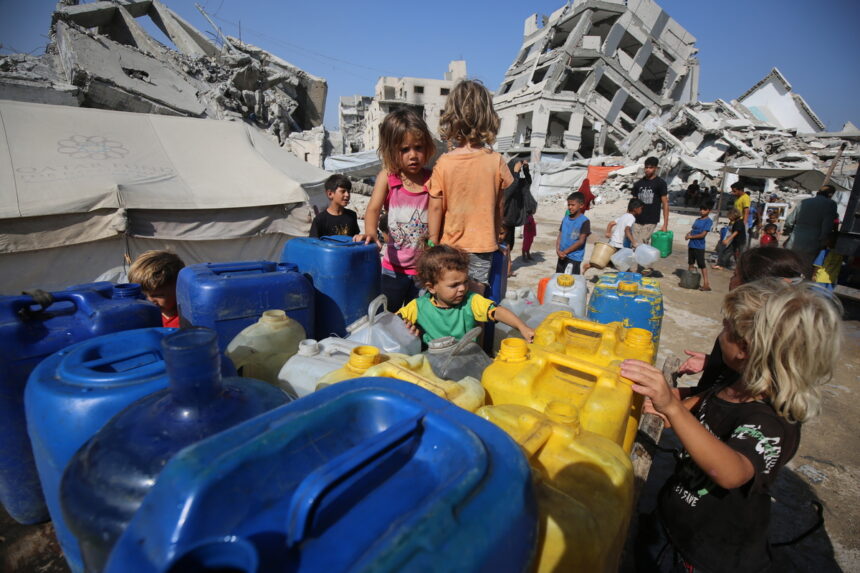The systematic destruction of Gaza’s water infrastructure has pushed the enclave’s population to the brink of an unprecedented humanitarian disaster. Walking through Jabalia refugee camp last week, I witnessed residents lining up with plastic containers at a solitary functioning water point – one of the few remaining sources in northern Gaza.
“We wait six hours for enough water to cook and clean,” explained Aisha Mahmoud, a 43-year-old mother of four. “Sometimes the children drink seawater mixed with groundwater because we have no choice.”
After ten months of conflict, Gaza’s water crisis has reached catastrophic proportions. According to the United Nations Office for the Coordination of Humanitarian Affairs (OCHA), over 96% of the enclave’s water infrastructure has been damaged or destroyed. This includes desalination plants, wastewater treatment facilities, and the network of pipes that once delivered water to homes.
The World Health Organization warns that Gaza residents now survive on approximately 2-3 liters of water daily – far below the emergency standard of 15 liters and the recommended minimum of 50-100 liters. This scarcity has devastating consequences beyond immediate thirst.
“Water infrastructure has been systematically targeted,” said Dr. Zaynab Al-Wazir, a public health specialist with Médecins Sans Frontières. “We’re seeing a dramatic rise in dehydration, kidney problems, and waterborne diseases like hepatitis A and dysentery, particularly among children and the elderly.”
My conversations with local officials revealed that repair efforts face nearly insurmountable obstacles. Equipment and materials needed to fix damaged water systems are blocked at border crossings. The few technicians capable of making repairs often cannot safely access damaged facilities due to ongoing military operations.
The destruction appears calculated. In December, Oxfam documented strikes on three major desalination plants within 48 hours, facilities that together had provided clean water to over 1.2 million people. The pattern of damage suggests what water experts call “hydraulic warfare” – the deliberate targeting of water systems to render territory uninhabitable.
“Water infrastructure is protected under international humanitarian law,” emphasized Juliette Touma, Director of Communications at UNRWA. “Deliberately targeting civilian infrastructure constitutes a serious violation of the Geneva Conventions.”
The crisis extends beyond drinking water. Sewage treatment has collapsed, causing untreated waste to flow into neighborhoods and the Mediterranean. This contamination creates a dangerous cycle – polluting the very groundwater sources desperate residents turn to when nothing else is available.
Economic impacts compound the suffering. Before the conflict, Gaza’s fishing industry employed thousands and provided vital protein. Now, coastline contamination has decimated fish populations and made harvesting dangerous for the health of consumers.
“We cannot fish, we cannot farm, and we cannot even drink safely,” said Khalil al-Najjar, a fisherman I interviewed on Gaza’s battered coastline. “How are we supposed to survive?”
International response has been insufficient. While aid organizations attempt to deliver bottled water and emergency desalination units, the scale of need far outstrips available resources. In Khan Younis, I observed an aid truck with water jugs surrounded by hundreds of desperate residents, many of whom would leave empty-handed.
The destruction of water infrastructure creates cascading effects beyond immediate thirst. Hospital directors report being unable to properly sterilize equipment or maintain basic hygiene standards. Schools that might reopen cannot provide safe drinking water for students. The social fabric tears as communities compete for scarce resources.
Displaced families sheltering in overcrowded UN facilities face particular hardship. At a school-turned-shelter in central Gaza, I met Ibrahim, an 8-year-old boy collecting condensation from an air conditioning unit in a plastic bottle. “This is for my baby sister,” he explained. “She’s sick and the regular water makes it worse.”
Water experts warn that the damage to Gaza’s aquifer – its primary groundwater source – may be irreversible. Years of over-pumping had already caused seawater intrusion, but the destruction of regulatory systems and wastewater treatment has accelerated contamination dramatically.
Restoration will require not just rebuilding physical infrastructure but addressing the complex hydropolitics of the region. Even before the current conflict, Gaza received only a fraction of its water allocation under international agreements.
“This isn’t just a humanitarian crisis; it’s an environmental catastrophe with generational consequences,” warned Dr. Natasha Carmi of the Geneva Water Hub. “Rebuilding water systems must be prioritized in any recovery plan.”
As night fell in Gaza City, I watched residents using flashlights to collect rainwater from a rare summer shower. The scene illustrated both the desperation and resilience of a population struggling to meet the most basic human need.
Without immediate action to protect remaining water infrastructure and facilitate repairs, public health experts predict catastrophic outcomes – particularly as summer temperatures rise. For Gaza’s population, the struggle for water has become inseparable from the struggle for survival itself.






